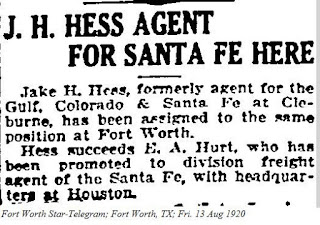© Kathy Duncan, 2015
I published this photograph in an early post. It is a copy of a photograph of Thomas Newton Yarberry that was sent to me by Kate Carson in the mid 1970s when I first started doing genealogy. I published it because it was of much higher quality that the photocopied version that I was seeing on the internet. I've noticed since then, that many on ancestry are using this clearer version, so it's nice to know that people really do read this blog.
Thomas Newton Yarberry's accepted date of birth is 27 January 1813; the source is a family bible researched by Kate Carson. According to the census, Thomas was born in North Carolina. He married Elizabeth Renfro/Rentfro in Gibson County, Tennessee on 22 April 1841. They were in Hempstead County, Arkansas by the 1850 census.
This photograph has always intrigued me. One of the things that I've always wondered about was what on earth was going on with his coat. Was it really as tattered and torn as it looks? Why would someone put on his worst garment to sit for a portrait, especially since people had very few pictures of themselves made in the nineteenth century? In looking at the bottom of the portrait, I always thought I saw damage that suggested that this is an ambrotype that someone had opened, damaging the paper on the back. That would mean, Thomas's photograph was damaged not his coat. That, however, was just a theory. Until the actual photograph came along for someone to look at, I only had a semi-educated guess. I proceeded to wait....oh, about 40 years or so.
Then, as luck would have it, a reader of this blog, and distant cousin, contacted me and sent me a digital copy of the original to which she temporarily had access. Isn't it breathtakingly wonderful?
I requested that she take pictures that would allow me to see the full photograph and its case. In return, I received the following two pictures, showing both the inside and the outside of the case.
Inside of Thomas N. Yarberry's photo case:
Outside of Thomas N. Yarberry's photo case, which I think is probably embossed leather:
At last, I had enough information to begin trying to date this photograph. Why is that important? For starters it would give us a clue as to how old Thomas N. Yarberry was when the photograph was taken and perhaps some insight into the occasion for which it was made.
I started with that area at the bottom that always looked like damaged paper to me. I blew up the bottom edge which you can see below. Definitely looks like damaged, thick paper:
The presence of this black paper identifies this as an ambrotype photograph. Ambrotype photographs were only produced for a decade, between 1855 and 1865. The image was directly on the glass with a thick piece of black paper or cloth behind it that made the image visible. That narrows this photograph down to 1855 - 1865.
Can the date range be narrowed further? Yes. Before 1859 the mats around ambrotype photographs were plain. Beginning in 1859 they began using fancy, embossed mats like the one around Thomas N Yarberry's photograph.
In 1859, the preservers around the mats became more elaborate and ornate - like the one around Thomas Yarberry's photograph.
Based on the type of photograph and its setting, Thomas N. Yarberry's photograph can be placed in a narrower date range: 1859 - 1865. Based on the wide range of ages given on the census, Thomas N. Yarberry's birth date can only be narrowed to 1813 - 1818. He would have been 41 - 46 in 1859 and 47 to 52 in 1865. However, if we stick with his accepted birth date of 1813, he would have been 46 in 1859 and 52 in 1865. His photograph features a man with a receding hairline, but no gray. It is hard to say what the occasion is for the photograph. It could be the Civil War. Did he serve in some way? So far, I have not found a service record for him unless he is listed under some tortured spelling of Yarberry. He was possibly too old to serve. Is it a photograph for a son to take to war with him? Is it for his 50th birthday? Still a lot of questions without answers.
I anticipate that people will use this photograph without permission. However, I do ask that you site this blog and that you leave a comment below.
Happy Father's Day to all our fathers, living and ancestral.





























